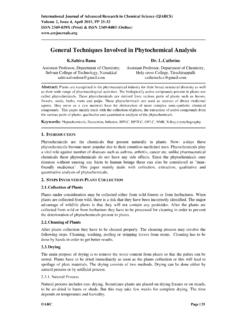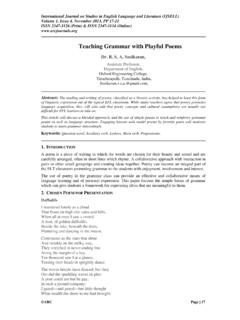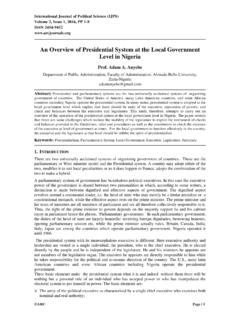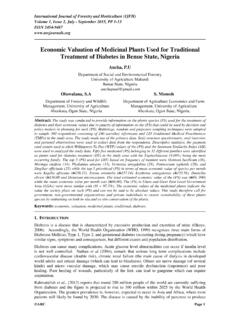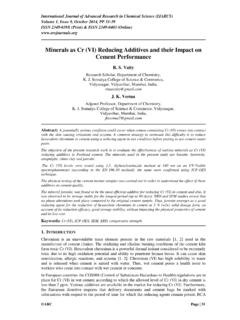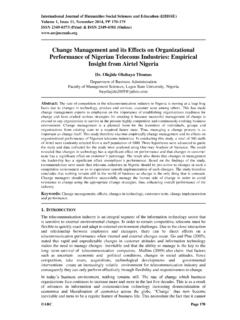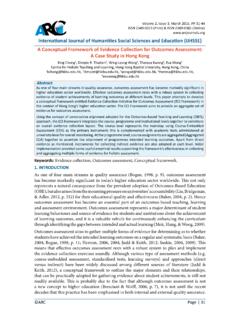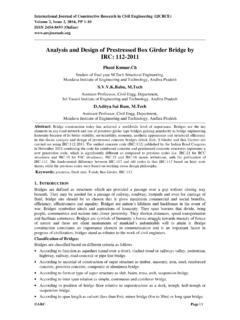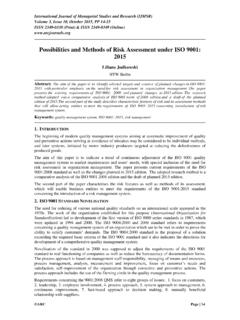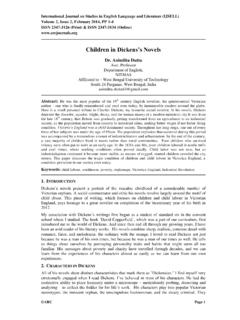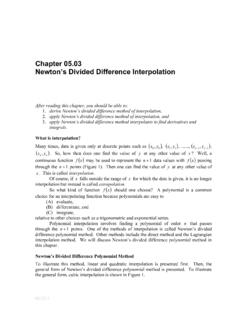Transcription of Exponential Matrix and Their Properties
1 International Journal of Scientific and Innovative Mathematical Research (IJSIMR) Volume 4, Issue 1, January 2016, PP 53-63 ISSN 2347-307X (Print) & ISSN 2347-3142 (Online) ARC Page | 53 Exponential Matrix and Their Properties Mohammed Abdullah Saleh Salman1,2 College of Education & languages, Department of Mathematics & Statistics, University of Amran. Amran, Yemen. Dr. Yeshwant Mahavidyalaya, Department of Mathematics & Statistics, Swami Ramanand Teerth Marthwada University, Nanded, India Abstract: The Matrix Exponential is a very important subclass of Matrix functions. In this paper, we discuss some of the more common Matrix Exponential and some methods for computing it. In principle, the Matrix Exponential could be calculated in different methods some of the methods are preferable to others but none are entirely satisfactory.
2 Due to that, we discussed computations of the Matrix Exponential using Taylor Series, Scaling and Squaring, Eigenvectors, and the Schur decomposition methods theoretically. Keywords: MatrixExponential, Commuting Matrix , Non-commuting Matrix . 1. INTRODUCTION The purpose of this note is Matrix functions, The theory of Matrix functions was subsequently developed by many mathematicians over the ensuing 100 years. Today, matrices of functions are widely used in science and engineering and are of growing interest, due to the succinct way they allow solutions to be expressed and recent advances in numerical algorithms for computing them []. In general is an interesting area in linear algebra, Matrix analysis and are used in many areas especially Matrix Exponential .The Matrix Exponential is a very important subclass of functions of matrices that has been studied extensively in the last 50 years []. The computation of Matrix functions has been one of the most challenging problems in numerical linear algebra.
3 Among the Matrix functions one of the most interesting is the Matrix Exponential . A large number of methods has been proposed for the Matrix Exponential , many of them of pedagogic interest only or of dubious numerical stability. Some of the more computationally useful methods are surveyed in [] In principle, the Matrix Exponential could be computed in many ways and many different methods to calculate Matrix Exponential [,9]. In practice, some of the methods are preferable to others, but none are completely satisfactory. 2. DEFINITIONS OF EXP(A): The functions of a Matrix in which we are interested can be defined in various ways. In mathematics, the Matrix Exponential is a function on square matrices analogous to the ordinary Exponential function [1,, , , 7]. Let A Mn. The Exponential of A, denoted by Ae or exp(A) , is the n n Matrix given by the power series (`1) )!
4 1(..!2!102nAAAIkAenkkA Where A0 = I Note that this is the generalization of the Taylor series expansion of the standard Exponential function. The series (1) converges absolutely for allnnCA has radius of convergence equal to +1), so the Exponential of A is well-defined. To prove the Convergence of the series, we have the following theorem. Mohammed Abdullah Saleh Salman & Dr. International Journal of Scientific and Innovative Mathematical Research (IJSIMR) Page 54 Theorem ( ) for more detail in [6]: The series (1) converges absolutely for allnMA . Furthermore, let be a normalized sub multiplicative norm on nM . Then (2) AAee Proof: The thn partial sum is 0!kknkAS So 11100!!!!!mkkmkkmkkkmkkknAkAkAkAkAkASe Since A is a real number and the right-hand side is a part of the convergent series of real numbers kkAkAe0! then this equation is convergent, if > 0 there is an N such that for m > n, !
5 1mkkAkAe This is sufficient to prove that nS is convergent. Furthermore, note that !!!000 AkkkkkkAekAkAkAe In some cases, it is a simple matter to express the Matrix Exponential of an nn complex Matrix A shall be denoted by Ae and can be defined in a number of equivalent ways []: (3) )(211dzAzIeieztAt Or (4) )1(lim kkAtekAt Or (5) 1X(0) , )(tAXdtdxeAt For details see [7], and we have other definitions but we leave it to reader to collect them. 3. COMPUTATION OF Exponential Matrix There are many methods used to compute the Exponential of a Matrix . Approximation Theory, differential equations, the Matrix eigenvalues, and the Matrix characteristic Polynomials are some of the various methods used. we will outline various simplistic Methods for finding the Exponential of a Matrix . The methods examined are given by the type of Matrix [,,8,9].
6 Exponential Matrix and Their Properties International Journal of Scientific and Innovative Mathematical Research (IJSIMR) Page 55 Computing Matrix Exponential for Diagonal Matrix and for Diagonalizable Matrices if A is a diagonal Matrix having diagonal entries then we have e e n21aa aAee Now, Let be nnRAsymmetric and has a complete set of linear independent Eigenvectors nvvv,..,,21 such that (6) ..n 1,2,..k kkkvAv let us define the Matrix T = [nvvv,..,,21] whose columns are the eigenvector of A corresponding to the eigenvalues of A, we have 12123,,..,,,..nATAv AvAvvvvT Since 1 TTA where nA 21 Now using 1 TTA to compute Ae and we can write it as follow 1 1k0kk10kkATTe)T k!1T()(T Tk!1k!Ae And hence 1 21 TeeeTenA Example: Consider the Matrix 1 0 00 5 00 0 3A then by using the above formula for diagonal form we get the Exponential Matrix is 153 0 00 00 0 eeeeA For diagonalizable Matrix we give this example Mohammed Abdullah Saleh Salman & Dr.
7 International Journal of Scientific and Innovative Mathematical Research (IJSIMR) Page 56 Example: Let 2 21 5A after found the eigenvalues and eigenvectors and construct Matrix T we use this formula 1 TTAto compute Aeas follow 43433434342e 22e e-2e 1- 11 2 0 0 2- 11 1eeeeeeeA Computing Matrix Exponential for General Square Matrices Using Jordan Normal Form Suppose A is not diagonalizable Matrix which it is not possible to find n linearly independent eigenvectors of the Matrix A, In this case can use the Jordan form of A. Suppose j is the Jordan form of A, with P the transition Matrix . Then 1 TTeejA Where )..(),..,,(1221112211jjjdiagjjjdiagjk Then )..(2211kkjjjJeeee Thus, the problem is to find the Matrix Exponential of a Jordan block where the Jordan block has the form kkkkMNJ)( and in general kN as ones on the thk upper diagonal and is the null Matrix if nk the dimension of the Matrix .
8 By using the above expression we have jjkkjkkkkkJNJkkNIkJkek0000)(!1)(!1!1 This can be written )!1(..!212nNNNI eenj Example: 16 4 46- 1- 56 17 21A Then we calculate the eigenvalues of A which are [] We have 1 PJPA then we calculate P which is 0 4 041 2- 4145 2 41P And Exponential Matrix and Their Properties International Journal of Scientific and Innovative Mathematical Research (IJSIMR) Page 57 16 1(4)0 16J Therefore, by using the Jordan canonical form to compute theexponential of Matrix A is 1616164164164164164164164e 16e 1622e- 59e- 922e 513e 1341eeeeeeeeeeA Using Hamilton Theorem Cayley Theorem (Cayley Hamilton) Let A a square Matrix and IA)( its characteristic polynomial then .0)(A Proof: Consider a nn square Matrix A and a polynomial p(x) and)(xbe the characteristic polynomial of A. Then write p(x) in the form )()()()(xrxqxxp by Cayley-Hamilton 0)(x , then p(A) = r(A) such that we can write polynomial )(!
9 1 XrXkkk Where )(xrk is the remainder of long division of !kxk by )(x , Then the Matrix Exponential can be written as 010)(!kknkkAArkAe thus Ae is a polynomial of A of degree less than n 10nkkkAAae Consider now an eigenvector v with the corresponding eigenvalue , Then vevkvAkvekkkkA00!1!1 Analogously vavAankkknkkk)(1010 and thus if we have n distinct eigenvalues so that the above equation is an interpolation problem which can be used tocompute the coefficients ka. In the case of multiple eigenvalues we use the corresponding generalized eigenvectors. Using Numerical Integration Consider the ODE Tk1,..0,0)(0,0,..0,e x(0) , kkAxx then when collect the solution from n to1 we get Mohammed Abdullah Saleh Salman & Dr. International Journal of Scientific and Innovative Mathematical Research (IJSIMR) Page 58 tAtAntAtAtAneIeeeeeeeetxtx),..,(),..,()( ..,),..(1211 then the general solution for above ODE is tAetX)( Now, by using numerical integrator with step mtt with IX0 we get 1-m0.
10 ,k ),,( 1kkkkXttXX That implies mtAXe Matrix Exponential Via interpolation Here we have two kinds as follow: A-Lagrange interpolation Formula Let n,..,,21be the distinct eigenvalues of a Matrix nMA and f(t) is any function that is well defined at the eigenvalues of A, then the Lagrange formula for Ae is kikjijjiittAIAeei,1(7) . newton 's divided Difference interpolation Let nMA be a Matrix with eigenvalues nA,..,,)(21 Now we define f(A) as follows (8) )( ],..,,[)(11121ijiniIAfAf Where ],..,,[21n is the divided difference at n,..,,21which defined 1n ].,..,..[].,..,..[].,..,..[11211nniifff where the value of divided difference is independent of the order of the arguments. 3, Using a Limit of Power From calculus we know that for any numbers a and t the Exponential (9) )1(limkkatkAe from equation (4)one can define the Matrix Exponential as a limit of powers as (10) )1(limkkAkAe This formula is the limit of the first order Taylor expansion of nA raised to the power Zn.
